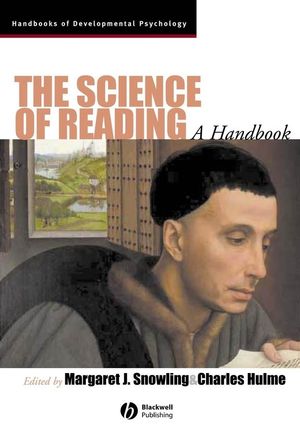The Science of Reading: A HandbookISBN: 978-1-4051-6811-3
Paperback
678 pages
November 2007, Wiley-Blackwell
 This is a Print-on-Demand title. It will be printed specifically to fill your order. Please allow an additional 10-15 days delivery time. The book is not returnable.
|
||||||
Preface.
Acknowledgments.
Part I: Word Recognition Processes in Reading:.
Editorial Part I.
1. Modelling Reading: The Dual-Route Approach: Max Coltheart (Macquarie University, Australia).
2. Connectionist Approaches to Reading: David C. Plaut (Carnegie Mellon University).
3. Visual Word Recognition: Theories and Findings: Stephen J. Lupker (University of Western Ontario).
4. The Question of Phonology and Reading: Guy C. Van Orden and Heidi Kloos (Arizona State University).
5. Eye Movements During Reading: Keith Rayner, Barbara J. Juhasz, and Alexander Pollatsek (University of Massachusetts).
Part II: Learning to Read and Spell:.
Editorial Part II.
6. Theories of Learning to Read: Brian Byrne (University of New England, Australia).
7. Writing Systems and Spelling Development: Rebecca Treiman and Brett Kessler (Washington University in St Louis).
8. Development of Sight Word Reading: Phases and Findings: Linnea C. Ehri (Graduate Center of the City University of New York).
9. Predicting Individual Differences in Learning to Read: Judith A. Bowey (University of Queensland).
10. Social Correlates of Emergent Literacy: Beth M. Phillips and Christopher J. Lonigan (Florida Center for Reading Research, Florida State University).
11. Literacy and Cognitive Change: José Morais and Régine Kolinsk (Université Libre de Bruxelles, Belgium).
Part III: Reading Comprehension:.
Editorial Part III.
12. Comprehension: Walter Kintsch and Katherine A. Rawson (University of Colorado).
13. The Acquisition of Reading Comprehension Skill: Charles A. Perfetti, Nicole Landi and Jane Oakhill (University of Pittsburgh).
14. Children’s Reading Comprehension Difficulties: Kate A. Nation (University of Oxford).
Part IV: Reading in Different Languages:.
Editorial Part IV.
15. Orthographic Systems and Skilled Word Recognition Processes in Reading: Ram Frost (The Hebrew University, Israel).
16. Early Reading Development in European Orthographies: Philip H. K. Seymour (University of Dundee, UK).
17. Learning to Read in Chinese: J. Richard Hanley (University of Essex, UK).
18. The Nature and Causes of Dyslexia in Different Languages: Markéta Caravolas (University of Liverpool).
Part V: Disorders of Reading and Spelling:.
Editorial Part V.
19. Developmental Dyslexia: Frank R. Vellutino and Jack M. Fletcher (State University of New York, at Albany).
20. Learning to Read with a Hearing Impairment: Jacqueline Leybaert (Université Libre de Bruxelles, Belgium).
21. Learning to Read with a Language Impairment: Margaret J. Snowling and Charles Hulme (University of York, UK).
22. Acquired Disorders of Reading: Matthew A. Lambon Ralph (University of Manchester) and Karalyn Patterson (University of Cambridge).
23. Spelling Disorders: Cristina Romani (University of Aston, UK), Andrew Olson (University of Birmingham, UK), and Anna Maria DiBetta (University of Aston).
Part VI: Biological Bases of Reading:.
Editorial Part VI.
24. Genetics of Dyslexia: Bruce F. Pennington (University of Denver) and Richard K. Olson (University of Colorado).
25. Functional Brain Imaging Studies of Skilled Reading and Developmental Dyslexia: Cathy J. Price (University College London) and Eamon McCrory (Institute of Psychiatry, UK).
Part VII: Teaching Reading:.
Editorial Part VII.
26. Teaching Children to Read: What Do We Know About How To Do It?: Catherine E. Snow (Harvard Graduate School of Education) and Connie Juel (Stanford University).
27. Recent Discoveries from Research on Remedial Interventions for Children with Dyslexia: Joseph K. Torgesen (Florida Center for Reading Research at Florida State University).
Glossary of Terms.
References.
Author Index.
Subject Index



